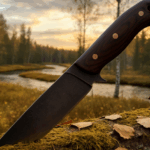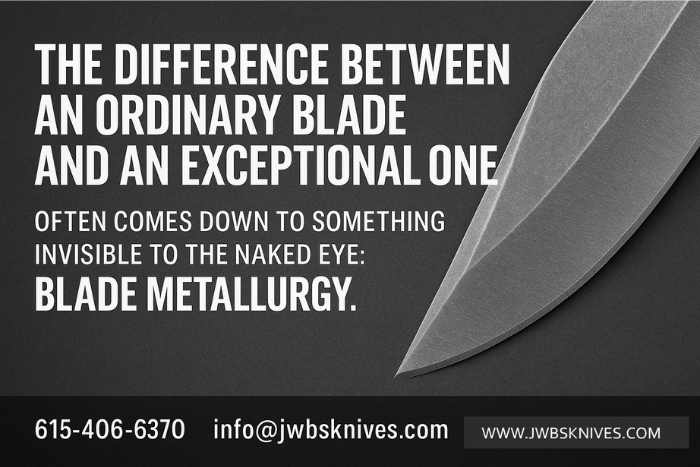

The difference between an ordinary blade and an exceptional one often comes down to something invisible to the naked eye: blade metallurgy. While aesthetics and design capture attention, the true performance of any knife is determined by the molecular structure of its steel and the precise processes used to transform raw metal into a cutting edge.
Understanding knife steel isn’t just for metallurgists and engineers. For collectors, outdoor enthusiasts, and anyone who values quality tools, knowing the science behind blade construction helps explain why some knives perform exceptionally while others disappoint.
At its most basic level, steel is an alloy of iron and carbon. But that simple description barely scratches the surface. The specific ratio of carbon to iron, combined with various alloying elements, creates dramatically different steel characteristics.
Carbon content is the primary factor determining a steel’s hardness and edge retention. Low-carbon steels (less than 0.6% carbon) are softer and more flexible. High-carbon steels (0.6% to 1.5% carbon) are harder and hold edges longer but can be more brittle if not properly heat-treated.
The art of custom knife making involves selecting the optimal carbon content for the blade’s intended purpose. A survival knife needs different characteristics than a collector’s display piece or a tactical blade.
Beyond carbon and iron, modern quality knives incorporate various alloying elements that enhance specific properties:
Chromium provides corrosion resistance. Steels with at least 13% chromium are classified as stainless, though this comes with trade-offs in edge retention and ease of sharpening.
Vanadium creates extremely hard carbides within the steel structure, improving wear resistance and helping maintain sharpness through extended use.
Molybdenum enhances strength and hardness while improving the steel’s response to heat treatment. It also contributes to corrosion resistance.
Manganese increases hardenability and helps remove impurities during the steelmaking process, resulting in cleaner, more consistent metal.
Nickel adds toughness and corrosion resistance, making steel less prone to chipping or breaking under stress.
The specific combination and proportion of these elements define a steel’s character. This is why experienced knife makers carefully select steel types based on intended use rather than simply choosing “the hardest” or “the most expensive” option.
Even the finest steel is worthless without proper heat treatment. This critical process involves precisely controlling temperature and cooling rates to achieve the ideal balance of hardness, toughness, and flexibility.
The heat treatment process typically involves several stages:
Austenitizing – Heating the steel to a specific temperature (usually between 1,450°F and 1,950°F depending on the steel type) where the crystal structure transforms and carbon dissolves uniformly throughout the metal.
Quenching – Rapidly cooling the steel in oil, water, or air to lock in the transformed crystal structure. The cooling rate dramatically affects the final properties.
Tempering – Reheating the hardened steel to a lower temperature (300°F to 1,000°F) to reduce brittleness while maintaining hardness. This step is often repeated multiple times for optimal results.
Master craftsmen understand that heat treatment isn’t a one-size-fits-all process. Different steels require different temperatures and timing. Even atmospheric conditions can affect results, which is why experience and precision matter enormously.
When discussing blade performance, you’ll often encounter Rockwell hardness ratings (HRC). This scale measures a material’s resistance to permanent indentation.
Most quality knife blades fall between 56 and 62 HRC. Lower numbers indicate softer steel that’s easier to sharpen but won’t hold an edge as long. Higher numbers mean harder steel with better edge retention but increased difficulty in sharpening and higher brittleness.
The optimal hardness depends on intended use. A knife that sees heavy outdoor use might benefit from slightly lower hardness (56-58 HRC) for increased toughness. A collector’s piece or precision cutting tool might target higher hardness (60-62 HRC) for maximum edge retention.
The finest steel in the world won’t perform well with poor edge geometry. The angle and shape of the cutting edge dramatically affect performance, and different steels support different geometries.
Harder steels can support more acute edge angles (15-20 degrees per side) without rolling or chipping, creating extremely sharp edges ideal for precision cutting.
Tougher steels perform better with slightly more obtuse angles (20-25 degrees per side), providing durability for demanding applications while sacrificing some initial sharpness.
Understanding this relationship between steel properties and edge geometry is crucial for knife craftsmanship. A blade must be designed holistically, with steel selection, heat treatment, and edge geometry all working together.
Among knife enthusiasts, few topics generate more discussion than the choice between stainless and carbon steel. Each has distinct advantages rooted in metallurgy.
Carbon steel (typically containing minimal chromium) offers:
Stainless steel (13%+ chromium) provides:
Neither is objectively “better.” The choice depends on intended use, maintenance preferences, and environmental conditions. A knife for marine environments benefits from stainless steel’s corrosion resistance. A precision cutting tool might favor carbon steel’s superior edge characteristics.
Knife metallurgy continues to evolve. Powder metallurgy processes create steels with extremely fine, uniform grain structures and high alloy content that would be impossible with traditional steelmaking methods.
These advanced steels offer impressive combinations of properties: high hardness with good toughness, excellent edge retention with reasonable sharpenability, and corrosion resistance without significant performance compromises.
However, advanced steels also present challenges. They’re more expensive, more difficult to work with, and require specialized heat treatment knowledge. For many applications, traditional steels still offer the best balance of performance, cost, and workability.
At JWBS Knives in Hendersonville, TN, steel selection and heat treatment are taken seriously. Each blade is crafted with careful attention to metallurgical principles, ensuring that the steel’s properties match the knife’s intended purpose.
This means understanding not just the theory of metallurgy, but how it translates to real-world performance. A hand forged knife isn’t just shaped metal—it’s the result of applying metallurgical science to create a tool that performs reliably for years or decades.
Understanding blade steel helps you make informed decisions:
For collectors, knowing steel types and heat treatment quality helps identify valuable pieces and avoid overhyped marketing claims.
For users, understanding metallurgy explains why some knives perform better in specific situations and how to maintain them properly.
For buyers, metallurgical knowledge cuts through marketing jargon to focus on what actually matters for your intended use.
While specifications and steel types matter, they’re not the complete story. A mediocre steel with excellent heat treatment will outperform premium steel with poor heat treatment. Similarly, the finest metallurgy won’t compensate for poor design or sloppy execution.
This is why custom knives from skilled makers often outperform mass-produced alternatives despite using similar steels. The difference lies in attention to detail, proper heat treatment, and understanding how all elements work together.
Metallurgical research continues to push boundaries. New alloy combinations, advanced heat treatment techniques, and innovative manufacturing processes promise even better performance in future blades.
However, fundamental metallurgical principles remain constant. Carbon content, alloying elements, heat treatment, and edge geometry will always determine blade performance. Understanding these basics provides a foundation for evaluating any knife, regardless of marketing claims or trendy new steel types.
📝 Contact Info JWBS Knives 📞 615-406-6370 📧 Info@jwbsknives.com 🌐 https://jwbsknives.com 📘 Facebook: https://www.facebook.com/JWBSForgesknives/ 📷 Instagram: https://www.instagram.com/jwbsknives/ 📍 Hendersonville, TN
Interested in learning more about the metallurgy behind custom knives? Contact us to discuss how proper steel selection and heat treatment create blades that perform exceptionally for decades.
Join our newsletter and stay up to date on all the custom products jwbsknives has to offer and read about custom techniques we use in the Forging Process of your next Hand Crafted Knife and Accessories.
After order is placed we will contact you about shipping cost with your choice of carrier.